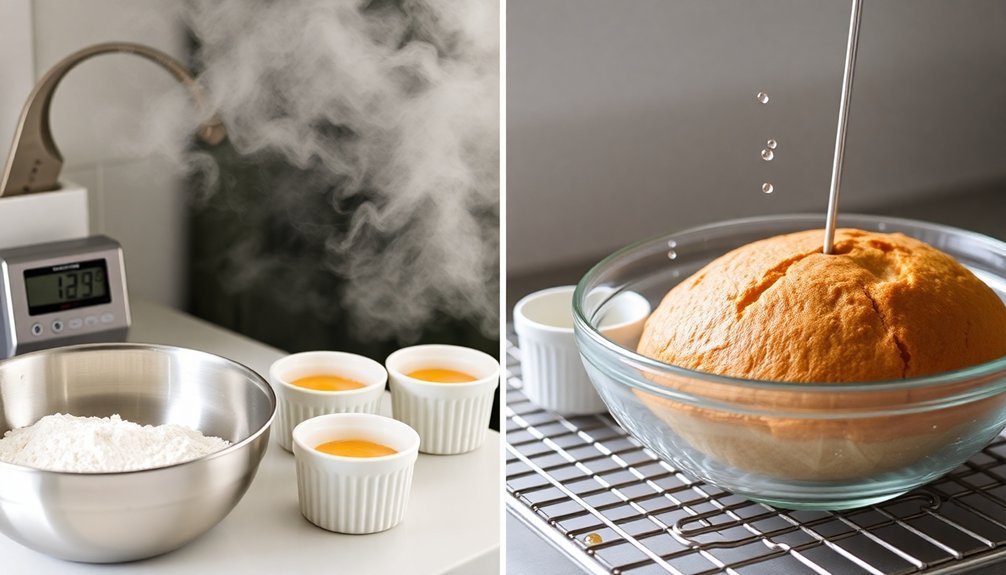To control moisture while baking, you'll want to master three essential techniques. First, generate steam effectively using methods like hot iron balls in a drilled ice pan or pre-heated cast-iron pans with boiling water. Second, regulate humidity by managing your oven's temperature and moisture levels – higher loads need more heat for proper evaporation. Third, monitor moisture content consistently using reliable tools like NIR sensors, which provide real-time readings with 0.1% to 0.2% accuracy. These fundamental approaches will improve your baking results, and there's much more to discover about perfecting your moisture control technique.
Steam Generation Techniques

Steam control stands at the heart of successful baking, whether you're working with professional equipment or home ovens. You'll find several effective methods to generate the moisture needed for ideal results.
For a DIY approach, you can use hot iron balls in a pie pan with a drilled ice-filled pan above it. As the ice melts onto the heated balls, it creates sustained steam throughout your baking process. A dutch oven setup provides excellent steam retention for achieving artisanal-quality bread at home.
If you're using a conventional home oven, try spraying water with a spray bottle before baking or placing a pre-heated cast-iron pan with boiling water inside.
In industrial settings, you'll benefit from built-in steam injection systems that offer precise control over moisture levels. These systems deliver timed bursts of steam, allowing you to fine-tune crust development and texture while maintaining consistent results across batches.
Humidity Control Methods
When baking at the highest level, mastering humidity control remains essential for achieving consistent, high-quality results. You'll need to monitor your oven load carefully, as more products increase humidity and require additional heat for water evaporation. Using extraction fans and dampers, you can effectively manage moisture levels during the baking cycle. For artisan bread baking, steam injection techniques help develop the desired crust character and texture.
| Control Method | Impact |
|---|---|
| Oven Loading | Higher loads increase humidity |
| Air Extraction | Removes excess moisture |
| Climate Control | Maintains ideal conditions |
| Environmental | Affects crust formation |
Don't forget to maintain proper humidity levels in your proofing areas, keeping relative humidity at least 75% for proper fermentation. You can use integrated climate control systems to balance temperature and moisture levels. Higher humidity delays crust formation for softer results, while lower humidity creates crispier products through faster evaporation.
Moisture Monitoring Solutions

Modern baking operations rely heavily on precise moisture monitoring technologies to maintain product consistency and quality. You'll find Near-Infrared (NIR) sensors mounted above conveyors, providing non-destructive, real-time moisture readings with accuracy levels of 0.1% to 0.2%. Regular calibration of these sensors ensures optimal moisture detection throughout production.
You can install these monitoring systems in various locations – after mixers, in hoppers, or along conveyor belts. When placing them near heat sources, you'll need proper cooling systems using air or water.
The technology integrates seamlessly with your PLC systems, enabling automated control of mixing and drying processes. You won't need to worry about ambient light interference, as these systems deliver repeatable results while inspecting 100% of your product.
This continuous monitoring helps you reduce energy costs, minimize waste, and maintain ideal moisture levels throughout your baking process.
Frequently Asked Questions
How Does Excess Humidity Affect Different Types of Flour During Baking?
When you're baking, excess humidity makes your flour absorb more moisture. You'll notice your all-purpose flour clumping, whole wheat becoming sticky, and pastry flour losing its fine texture. It'll affect your dough's consistency.
Can Humidity Levels Impact the Effectiveness of Chemical Leavening Agents?
Yes, humidity will affect your chemical leaveners' performance. You'll notice slower gas release in high humidity, which can impact your dough's rise. It also influences how effectively your baking soda and powder work.
What Role Does Altitude Play in Moisture Control During Baking?
At higher altitudes, you'll find liquids evaporate faster due to lower air pressure. This affects your baking by drying out goods more quickly and requiring you to adjust liquid amounts and cooking times.
How Should Recipe Ingredients Be Adjusted When Baking in Humid Conditions?
You'll need to reduce liquid content, increase flour slightly, and use less yeast in humid conditions. Consider using bread flour instead of all-purpose, and add extra fat to help control unwanted moisture absorption.
Does Oven Humidity Affect Gluten Development Differently in Various Dough Types?
Yes, you'll notice that high-protein doughs are more sensitive to oven humidity, affecting their gluten development considerably, while cake batters and low-protein doughs show less dramatic changes in their gluten structure.
In Summary
You've now learned the key techniques for managing moisture in your baking. Whether you're using steam generation for crusty breads, controlling humidity levels for delicate pastries, or monitoring moisture content for perfect results, you'll find these methods invaluable in your kitchen. Put these strategies into practice, and you'll notice a significant improvement in your baked goods' texture, appearance, and overall quality.





Leave a Reply